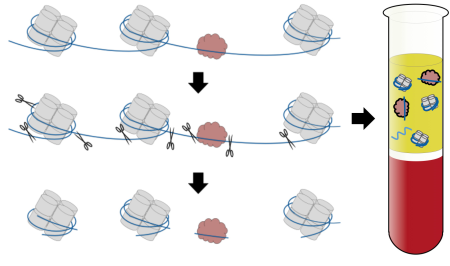
Caption: DNA (blue) loops around nucleosomes (gray) and is bound by transcription factors (red), proteins that switch genes on and off and act in a tissue-specific manner. When cells die, enzymes (scissors) chop up areas between the nucleosomes and transcription factors, releasing DNA fragments in unique patterns. By gathering the released DNA fragments in blood, researchers can tell which types of cells produced them.
Credit: Shendure Lab/University of Washington
Credit: Shendure Lab/University of Washington
From Genomics & Health Impact Scan Database
This database includes published scientific literature on evidence-based translation of genomic discoveries into improved health care and disease prevention that have a potential impact on population health.
- ASCO 2016: Liquid Biopsy May Help Guide Treatment Decisions for Patients With Advanced Solid Tumors

ASCO Post, June 4, 2016 - 'Liquid biopsy' blood test detects genetic mutations in common form of lung cancer

eCancer News, April 8, 2016 - Pathway launches 'liquid biopsy' to find cancer in healthy people,

by Julie Steenhuysen, Reuters, September 10, 2015 - Liquid biopsy: will it be the 'magic tool' for monitoring response of solid tumors to anticancer therapies?

Gingras Isabelle et al. Curr Opin Oncol 2015 Sep 1. - A perfect blood test for pancreatic cancer?

By Elaine Schattner, Forbes, Jul 6






















.png)









No hay comentarios:
Publicar un comentario